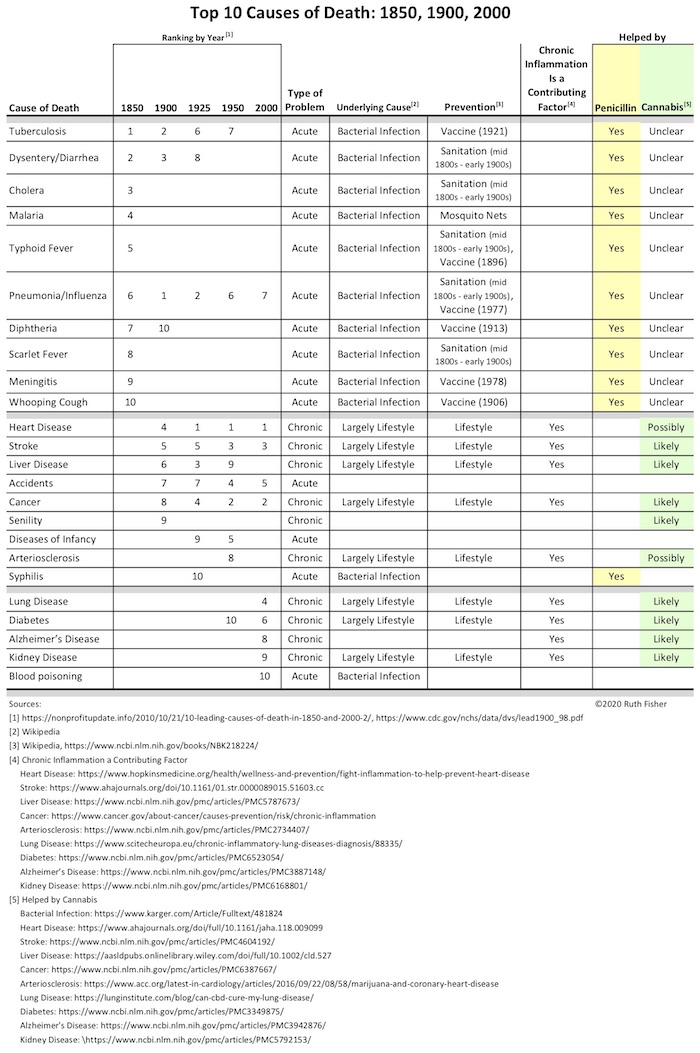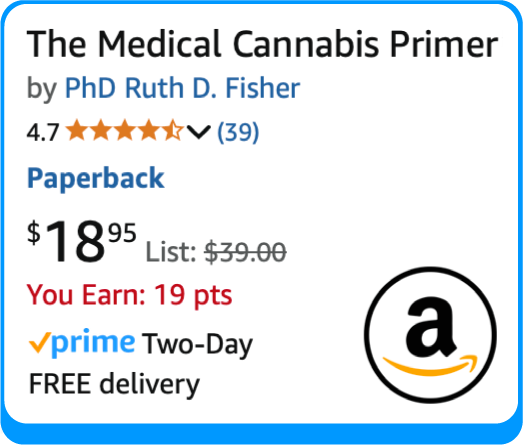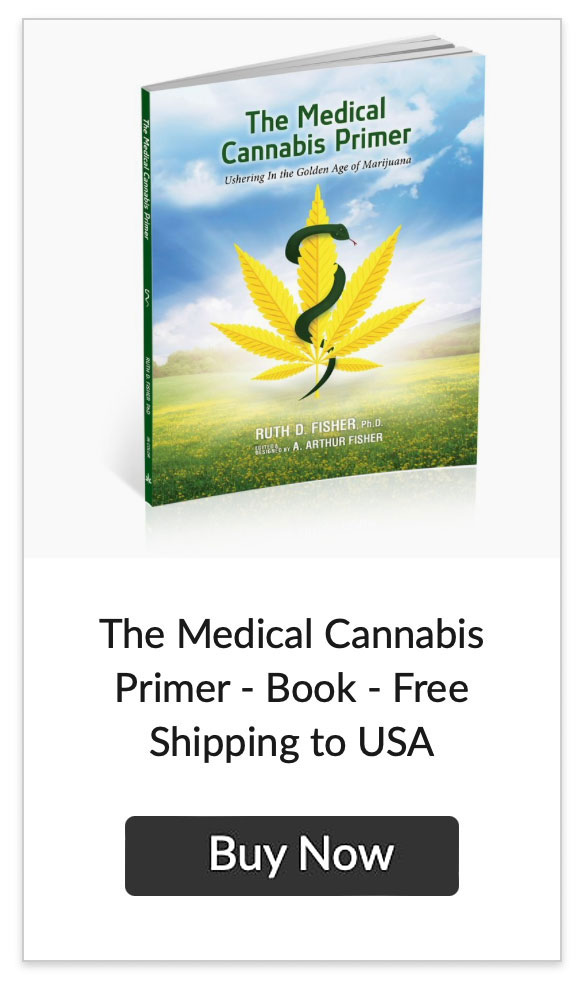Blogs
Cannabis: A Penicillin for the 21st Century
Ruth Fisher
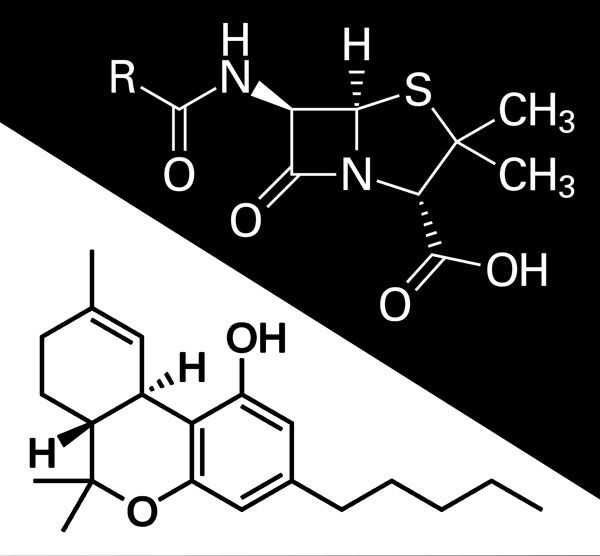
Throughout history, bacterial infections have been the scourge of human beings. Up until the early 1900s, the top 10 leading causes of death globally were all bacterial infections, most of them infectious diseases. Between the late 1800s and early 1900s, however, the introduction of public sanitation measures, together with the advent of vaccines, significantly curtailed death from bacterial infections, particularly in more developed nations. Nonetheless, while sanitation and vaccinations prevent much bacterial infection from occurring, they certainly do not eliminate all infections, nor do they treat the infections that do occur.
The invention and commercialization of penicillin during the mid-to-late 1930s largely changed the impact of bacterial infections and disease on society. While bacterial infections still account for two of the top 10 causes of death globally,[1] millions of lives have been saved, thanks to penicillin and the other antibiotics that penicillin’s development engendered. Since sanitation, vaccination, and penicillin have become more widespread, the leading causes of death have shifted away from acute problems and toward chronic disease.
Due to its impact on saving lives, penicillin has been considered a miracle drug.[2] Certainly, the fact that penicillin has saved so many lives is reason enough to warrant this exceptional designation. However, penicillin has had a tremendous impact on society for additional reasons as well: penicillin’s development and commercialization (i) served as a forerunner for all other antibiotics as well as many new bioproducts, (ii) pioneered a wide variety of new technologies, and (iii) created a fundamental change in the relationships between industry, universities, and governments. In fact, many would call penicillin the most important medication of the 20th Century.[3]
Our understanding of cannabis and our endocannabinoid systems are still in their infancies. Yet, based on what little I know, I expect cannabis will be one of the most important medications of the 21st Century: not only does cannabis have the potential to increase the quality of life for millions of people worldwide, but it is also spurring the same types of other changes in society that penicillin did 75 years ago. In particular, I believe the development and commercialization of cannabis will (i) serve as the impetus for researchers to develop a much better overall understanding of how the body works (not just for humans, but for all animals), (ii) serve as a forerunner for a fantastic variety of products, forms of use, and methods of delivery for addressing an incredible array of health and wellness conditions; (iii) serve as the impetus for a wide variety of new technologies, spanning, among others, biology, chemistry, botany, nanotechnology, and blockchain; and (iv) serve as the impetus for changing the relationship between government, the traditional healthcare industry (science), the traditional cannabis community (technology), and cannabis patients.
Penicillin: Medication of the 20th Century
Nelson Kardos and Arnold Demain[4] beautifully and succinctly summarize the historical impact of penicillin on society:
The clinical impact of penicillin was large and immediate. By ushering in the widespread clinical use of antibiotics, penicillin was responsible for enabling the control of many infectious diseases that had previously burdened mankind, with subsequent impact on global population demographics. Moreover, the large cumulative public effect of the many new antibiotics and new bioproducts that were developed and commercialized on the basis of the science and technology after penicillin demonstrates that penicillin had the greatest therapeutic impact event of all times.
…The basis for nominating penicillin as having the greatest impact on therapeutic outcomes is based on the following criteria:
- The development of antibiotics and their availability for widespread therapeutic use led to a significant new approach for infection control and health care.
- Penicillin represents the first defined therapeutic product isolated from microbial sources and is the forerunner for development of all antibiotics to date.
- The technologies developed for the production of penicillin, including microbial strain improvement and chemical engineering methods to mass produce fermentation products, have provided the basis for production of all classes of antibiotics to date. The development of penicillin represents the combined efforts of several diverse scientific disciplines, including chemistry, biochemistry, microbiology, and chemical engineering.
- Development and production of many new bioproducts with diverse clinical applications including cancer, auto-immune diseases, new vaccines, etc. are dependent on the same microbial strain selection and large-scale chemical engineering methods that were first pioneered for penicillin.
- The development of penicillin during World War II marked a fundamental change in the relationship between government, private industry, and universities for collaboration and funding to support medical research.
Figure 1 provides Kardos and Demain’s list of technologies employed in the development of penicillin.
Figure 1
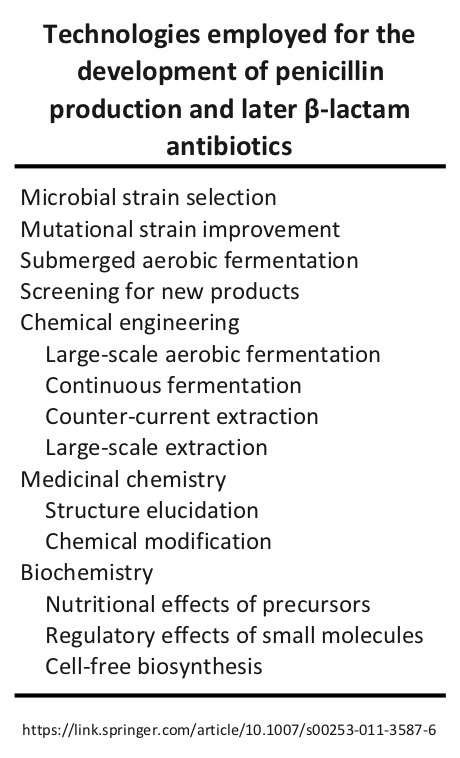
Discovery of the ECS
Thanks to a combination of sanitation, vaccination, and in no small part to penicillin, acute health problems no longer serve as the major causes of death that they did for so long. Penicillin and other antibiotics now address a wealth of acute health problems associated with infection, injury, and accidents.
Since most of the pervasive acute problems are now treatable, chronic conditions have become the cause of most deaths in today’s world. Our bodies have developed over millions of years to create fantastically intricate control systems that keep our bodies functioning in a wide variety of environments. Yet, our lifestyles have changed too rapidly over the past 100 years for our bodies to be able to adapt. As a result, our control systems have become dysregulated, causing so many of us to suffer from chronic conditions.
It was the quest to understand how cannabis works on our bodies that led to the discovery of the endocannabinoid system (ECS) in the 1990s. Since then, scientists have been discovering how our ECSs serve as the major control systems that work to promote homeostasis throughout our bodies. New research is revealing how a vast array of health and wellness problems can be addressed by modulating ECS activity, that is, by using medications that act on the ECS. Furthermore, in addition to spawning treatments for a host of medical conditions, cannabis and ECS researchers have also been following the path of penicillin in pioneering both new technologies as well as new relationships across different sectors of society. I believe cannabis will serve 21st century populations just as antibiotics served 20th century populations.
Role of the ECS: Maintaining Homeostasis
Understanding how penicillin works in our bodies is relatively straightforward: bacteria invade our bodies, and if our bodies’ immune systems aren’t able to fight off the bacteria well enough, we get sick and perhaps die. What penicillin does is kill the bacteria. It aids our own immune systems in vanquishing the threat, so our bodies can return to normal functioning.
Understanding how cannabis works to improve and maintain health is a little more complex. Relatively recently – in the 1990s – researchers discovered a system in our bodies that's naturally designed to make sure all of our other systems – cardiovascular, digestive, immune, and so on – stay within the bounds of normal functioning. This system that’s responsible for maintaining homeostasis, that is, functioning within limited boundaries, is called the endocannabinoid system (ECS), named after the chemicals in cannabis, cannabinoids, that led to the system’s discovery. Researchers discovered that, just like penicillin helps our immune systems fight off bacteria, cannabinoids and other compounds in cannabis help our ECSs make sure our bodies are functioning within normal limits.
Over the past 100 years or so, the lifestyles of most people have changed. In particular, we experience more chronic stress, engage in less physical activity, and eat more processed (unhealthy) foods than we used to. Our systems have been overtaxed to the point that they no longer function within healthy bounds, that is, our ECSs are no longer able to maintain homeostasis, thereby causing so many of us to experience chronic disease. Cannabis, however, helps our ECSs to restore functioning to within more normal limits. Cannabis, then, restores health by helping us better manage – if not treat – chronic conditions.
As an aside, not everyone 100 years ago was necessarily healthier than people are today. Yet, back then, people who might have developed the same chronic conditions that so many of us suffer from today died earlier in life from bacterial infections, thereby preventing them from living long enough to suffer from chronic disease. Now that people no longer die from acute diseases, they are living long enough to develop more chronic conditions.
Figure 2 provides a table displaying the top 10 causes of death in the US for select years between 1850 and 2000. As previously described, in 1850, all of the top 10 causes of death were bacterial infections. By 1900, a combination of public sanitation measures and vaccinations had help reduce deaths from bacterial infections by preventing disease. By 1925, the number one cause of death was heart disease, a chronic condition.
Figure 2
Click for larger version
Penicillin was invented in 1928 but didn’t become more widely available until 1943, during WWII. While sanitation and vaccination were helping to prevent many infections, they couldn’t prevent them all. Yet, after penicillin became available, getting an infection was no longer a death sentence, because now penicillin could be used to treat infections. This new ability to treat more diseases (using penicillin and other subsequent medical innovations) is reflected in the changes in the death rate over time. In 1900, 1,719 people died each year for every 100,000 people in the population. By 2000, only 873 people died each year for every 100,000 people in the population. In other words the death rate in 2000 was only 51% of that in 1900.[5] (I couldn’t help looking up the numbers for more recent years: In 2017, there were a total of 2,813,503 deaths[6] from a population of 325.1 million people, equivalent, to a death rate of 865 people, or 50% of the rate in 1900.)
A pervasive problem many of us suffer from today is chronic inflammation. When our bodies normally respond to threats in the environment, our immune systems are activated: Fluids flow to the area of attack, thereby enabling killer cells to come in and address the threat. It is these fluids that cause inflammation. Once the threat has been destroyed, our immune systems go into restoration mode: the fluids dry up, cleanup cells come in to carry away cells killed in the fight, and repair cells come in to repair any tissue damage and restore normal functioning. The problem we’re having today is two-fold. First, because our bodies are chronically threatened — by continually experiencing stress, leading sedentary lives, eating the wrong foods, and so on — our immune systems are chronically activated to address these ongoing attacks on our bodies. And second, as our immune systems spend so much time being activated, they end up causing collateral damage to other parts of our bodies, thereby further inducing inflammation. While we have natural systems designed to keep our systems in balance (the ECS), our natural systems are simply overwhelmed by our continually unhealthy lifestyles.
What cannabis does is buttress our ECSs to help our own natural systems address the problems — inflammation in particular — being caused by unhealthy lifestyles. The compounds in cannabis are similar enough to the compounds our bodies produce so as to be able to work in conjunction with our natural systems. Using cannabis, then, is like sending in the cavalry to help fight the enemy. With externally supplied reinforcements, our natural ECSs are then able to overcome much of the damage caused by unhealthy lifestyles.
Cannabis Engendered Medications
As more becomes known about the ECS, researchers will discover more ways in which our health and wellness can be better treated and managed using (i) cannabis (the plant), (ii) cannabinoid derivatives (synthetics), (iii) endocannabinoids (the cannabinoids produced by our bodies), and (iv) other non-cannabinoid ECS therapeutics, such as psychedelics.
There is already a fantastic variety of cannabis forms and formulations available to customers, much more than those for other therapeutics. Customers can smoke, dab, or vape hundreds – if not thousands – of different profiles of cannabis products. Customers can use cannabis tinctures, sublinguals and films, salves and balms, topicals and transdermals, pills, suppositories, food and beverages. Additionally, new forms and formulations of cannabis products are being developed and regularly released into the market.
Researchers are developing an array of cannabinoid-based therapeutics using cannabis and synthetic cannabis derivatives (e.g., Marinol, Sativex, Epidiolex), as well as endocannabinoids and synthetic endocannabinoid derivatives. And as researchers learn more about the ECS, they will discover new, non-cannabinoid therapeutics to help address ECS dysfunction.
Pioneering Technologies in Cannabis
As previously mentioned, Kardos and Demain describe a wide variety of “technologies developed for the production of penicillin,” which span “several diverse scientific disciplines, including chemistry, biochemistry, microbiology, and chemical engineering.” As with penicillin, the development and commercialization of cannabis is leading to a wide spectrum of new technologies that draw from and build-on currently cutting-edge technologies in genomics, chemistry, nanotechnology, and botany, among others.
Cannabis Production
- Plant Genomics
Cutting-edge technologies: genetic sequencing, genetic engineering
A “crude map” of the cannabis genome was first published in 2011. The technology of the time was lacking, so much information about cannabis genetics remained unknown. Over the next several years, new “long read” genetic sequencing technology was developed. In 2018, “an updated, high-resolution [cannabis] genome build was published… A well-characterized genome … opens the door to the genetic engineering of the plant itself.” Breeders are creating new varieties of cannabis with, among other changes, greater trichome yields, unique profiles of compounds, improved flower structure, greater resistance to disease, and improved nutrient uptake.[7]
- Cultivation Systems
Cutting-edge technologies: sensor-based systems to optimize the complexities of the grow environment to generate quality, consistency, and uniformity in output
One of the big problems with cannabis is providing product that is consistent in its chemical profiles from plant to plant. There are several essential factors in the cannabis grow environment that affect the quality and consistency of cannabis produced, including: (i) lighting, (ii) temperature, air circulation, and humidity, (iii) carbon dioxide levels, (iv) watering, and (v) nutrients.[8] Many new technologies are being developed to address each of these subjects to help growers generate better outcomes. Notably, there are many sensor-based technologies being developed to help manage the entire grow process.[9]
- Plant Processing
Cutting-edge technologies: component extraction and purification technologies
Once cannabis has been harvested, it may be cured, fresh frozen, decarboxylated, extracted, purified, otherwise processed, and/or formulated into end-products. During and after cannabis end-products have been generated, plant material must be stored, packaged, and labeled. New technologies are being developed to improve outcomes in each of these areas.
- Product Testing and Detection
States that have legalized cannabis generally require end-products to be lab-tested before they can be sold to consumers. Testing specifications vary by region and include some combination of testing for (i) profiles of cannabinoids, (ii) terpenes, (iii) bacteria, (iv) mold, (v) pesticides, (vi) heavy metals, (vii) residual solvents, and (viii) other potential toxins (e.g., vitamin E acetate).
Cannabis lab testers have been using standard (non-cannabis-specific) testing equipment (gas/liquid chromatography). Lack of standardized cannabis testing protocols, together with cannabis-related idiosyncrasies, leave room for improvement in cannabis testing technology. Specifically,
While gas/liquid chromatography (the industry’s standard) may provide accurate results, it is costly and has a long waiting time; whereas, field kits for on-site testing are relatively affordable but do not provide results that are accurate enough to meet the stakeholder’s requirements and needs…
Industry personnel indicated “an accurate, reliable, on-site test for THC and CBD potency is widely and ardently welcomed… such a test would save time, cost and reliance on third party tests, as well as improve bargaining position.”[10]
In fact, several cannabis testing kits and devices have recently been patented, and I’m sure plenty of others are in development.
At the same time, there have also been many recent patents on testing kits and devices for detecting cannabis presence in human breath and body fluids.
Distribution and Sale
- Tracking and Management
Cutting-edge technologies: blockchain tracking technologies
Cannabis industry providers must adhere to stringent tracking and reporting regulations for all production, processing, and movement of cannabis through the supply chain, from seed-to-sale. There are sector-specific tracking and reporting systems designed to help cultivators, processors/manufacturers, distributors, and dispensaries manage and track inventories and sales. Additionally, there are systems designated by each state to be used to comply with state-wide tracking and reporting requirements. Some of the more sophisticated tracking systems use blockchain technologies.
- B2B and B2C Matching
Thousands of cannabis products currently exist in the market with complex restrictions on where specific products are legally available. New technologies are being developed to help consumers find specific cannabis products available to them.
Cannabis products contain complex combinations of compounds that affect people differently, depending on their individual makeups. New technologies are being developed to help cannabis users find cannabis products that meet their individual needs.
New technologies are also being developed to help match buyers and sellers of raw materials and of processing services and equipment.
- Payment Systems & Banking Services
Cutting-edge technologies: non-bank payment systems including blockchain technologies
Due to the Schedule I status of cannabis, cannabis industry participants are unable to access traditional banking and payment services. Novel technologies have been developed that enable industry participants to utilize payment systems that bypass the traditional banking sector.
Health
- ECS
Cutting-edge technologies: Endocannabinoid science, advanced imaging techniques, biotechnology, cheminformatics
The discovery of the endocannabinoid system (ECS) has created a whole new area of science. Therapeutics are being developed in the following areas for use in improving health and wellness:
-
- Phytocannabinoids (from the cannabis plant)
- Cannabinoids (synthetic derivatives)
- Endocannabinoids (produced in our bodies)
- Endocannabinoid system (other non-cannabinoid therapeutics, including cannabis derivatives grown from yeast or algae, psychedelics, etc.)
- Compound interactivity (whole plant, drug cocktails, entourage effects)
- Human genetics
Cutting-edge technologies: Human genetics and genomics
Researchers have established that the effects of particular combinations of cannabis compounds on individuals are at least in part genetically-determined. This understanding has created considerable research activity into human genetics and genomics and cannabis. More and more companies are developing technologies that match customers with cannabis products better suited to their genetic profiles.
- Delivery Methods and Systems
Cutting-edge technologies: nanotechnology for emulsification and encapsulation, vaporization, mucosal films
Three challenges in particular related to using cannabis to improve health and wellness are currently the subject of much research and development activity:
-
- Fixed dosing: delivering constant doses of ingested (smoked or vaped) products
- Bioavailability: increasing the amount of active ingredients absorbed by the body
- Targeted delivery: delivering active ingredients to specific parts of the body to minimize dosing and incidence of side effects
- Wellness
Researchers are finding increasing applications of cannabis to health and wellness, and technologists are developing cannabis-based foods, supplements, and nutraceuticals.
The Changing Nature of Provider-Patient Relationships
Kardos and Demain explain three different ways the use of penicillin changed the relationship and scope of practice between doctors and patients:
For example, [1] use of antibiotics enabled a fast throughput in general medical practice because they could be quickly administered or prescribed after a short visit with the general practitioner. This innovation enabled a wider use of health services by the general public and a greater demand for medical services. [2] People with infections could now be effectively treated. This was a great change from previous social attitudes that dictated that people suffering with infectious disease were to be avoided and not treated. [3] In addition, surgeons could undertake more complex operations on patients now protected from infection. It is not an exaggeration to state that the great developments in modern surgery in the last 60 years could not have taken place without the availability of antibiotics as protective agents. [11]
Like penicillin, cannabis has the potential to create significant changes in the doctor-patient relationship. First, cannabis is personalized medicine. The right form and dose is different for each patient. Patients will play a larger role in directing their cannabis treatments than they do with traditional medications. More specifically, patients will have more choices regarding forms of use, which will make the prospect of taking their cannabis medication easier or more convenient than other medications. Also, patients will be more involved in tracking the effects of different cannabis products on their health and wellness and adjusting their formulations and doses when needed.
Second, cannabis enables providers to help patients better manage a variety of problems that doctors have thus far not been able to address very well. In particular, cannabis holds the promise to better treat inflammatory diseases, including degenerative neurological illnesses, such as Alzheimer’s Disease, Parkinson’s Disease, and multiple sclerosis, which have generally eluded treatment.
Third, cannabis offers a way for people to address a huge variety of health and wellness issues, like no single medication has ever been able to before.
Traditional Healthcare vs. Traditional Cannabis
Kardos and Demain explain how “the development of penicillin during World War II marked a fundamental change in the relationship between government, private industry, and universities for collaboration and funding to support medical research”:
It was the combination of (a) primary discoveries in university laboratories and (b) the efforts of the chemical industry to develop practical methods for scale-up of production on a reliable and low-cost basis that enabled penicillin to be developed as a drug with great clinical efficacy and then to be produced reliably on an industrial scale. This collaboration was underwritten by large-scale funding from the US government and later from the British government. Such major funding from the public sector was essential for success. The universities just did not have the resources for such a massive research program. Furthermore, at the time, private industry was not willing to accept the risks for developing an unproven drug with many production-scale challenges. It was the pressures of wartime emergency that pushed the US government to fund this vast program. It was the government funding of the wartime penicillin program that served as the prototype for future US and British government funding of basic and applied medical research and has enabled effective research collaboration between universities and private industries ever since.” [12]
As with penicillin, the development of cannabis will shape future relationships between traditional science and government on the one hand and the traditional cannabis and whole plant communities on the other hand.
In ancient times, science (research) and technology (industry) existed in separate realms of society. The two realms slowly merged over a span of about 300 years that encompassed the Scientific Revolution (1543 – 1687), the Glorious Revolution (1688 – 1689), and the Enlightenment (1680s – 1820). In addition to the integration of science and industry, sustained development of society also required (i) accessible repositories of information, (ii) property rights regimes, and (iii) widespread science education.
Yet, even while science and industry were integrating throughout the rest of society, the banning of cannabis (by The Marijuana Tax Act of 1937 and later by the 1970 Schedule I classification of cannabis) precluded this dynamic in cannabis, just as its use was gaining hold in society. Science continued in fits and starts within the realm of universities and research labs (the traditional healthcare community). Technological and industrial progression, on the other hand, was carried out by black market participants (growers and users in recreational and alternative healthcare markets), who were disconnected from researchers.
During the 1980s and 1990s, the AIDS crisis and the discovery of the ECS together started opening society to the possibilities of cannabis by medically validating its use. Still, it wasn’t until the turn of the 21st century that cannabis science and industry truly started to merge, and since then, they have mushroomed. Yet, what will sustain the growth and development of cannabis are the same factors that served to sustain growth in science and technology throughout the rest of society: (i) accessible repositories of information, (ii) property rights regimes, and (iii) widespread science education. Amazingly, over the past decade, a massive frenzy of activity has emerged in science and industry to aggregate what is known about cannabis and make it more accessible to members of the cannabis community, to establish property rights for new inventions and innovations, and to create programs for educating and credentialing members in cannabis. It is these latter efforts to create and maintain a repository of information and an educated cannabis community that will serve as the basis for enabling cannabis science and technology to continue to flourish.
Nevertheless, there remains a fundamental disagreement between members of the traditional healthcare community and members of the traditional cannabis community about the form of cannabis that’s appropriate for medical use. The traditional healthcare community, backed by government, supports FDA-approved, purified isolates as the optimal form of medication for patients. The traditional cannabis community, on the other hand, supports whole plant cannabis extracts (so-called alternative medicine) as being the optimal form of cannabis medication for patients. I believe the way in which this disagreement is eventually settled will shape the future of the healthcare industry.
One possibility is that advances in science and technology enable traditional industry researchers to disentangle and clearly articulate the interactions between different constituents of the cannabis plant. This would enable pharmaceutical companies to produce FDA-approved compounds with multiple active ingredients. In this case, alternative medicine (so-called crude extracts) will continue to be relegated to second-class status in society, or at least among members of the traditional healthcare community.
The alternative is that advances in science and technology enable whole plant researchers to products clean (GMP) and consistent whole plant products that pass muster with the traditional healthcare industry. In this case, whole plant cannabis would be elevated to peer status within the traditional healthcare community. This path for cannabis would also pave the way for other non-traditional whole plant healthcare alternatives (e.g., psychedelics) to become more accepted in society.
References
[1] https://www.who.int/gho/mortality_burden_disease/causes_death/top_10/en/
[2] https://www.livescience.com/65598-penicillin.html
[3] https://www.proclinical.com/blogs/2016-6/top-10-most-important-drugs-in-history
[4] Kardos, N. and Demain, L. (2011). Penicillin: the medicine with the greatest impact on therapeutic outcomes. Appl Microbiol Biotechnol. Retrieved from https://link.springer.com/article/10.1007/s00253-011-3587-6
[5] https://www.cdc.gov/nchs/data/dvs/lead1900_98.pdf
[6] https://www.cdc.gov/nchs/data/nvsr/nvsr68/nvsr68_06-508.pdf
[7] https://www.pnas.org/content/pnas/116/18/8638.full.pdf
[8] https://www.leafly.com/news/cannabis-101/factors-that-impact-your-cannabis-strain-part-2-environment, https://www.ilovegrowingmarijuana.com/create-best-climate-marijuana-grow-room/
[9] See, for example, patent # 10681879 issued in Jun 2020. https://patents.justia.com/assignee/avid-growing-systems-inc
[10] https://www.europeanpharmaceuticalreview.com/news/123569/report-calls-for-development-of-new-cannabis-testing-technologies/
[11] Kardos, N. and Demain, L. (2011). Penicillin: the medicine with the greatest impact on therapeutic outcomes. Appl Microbiol Biotechnol. Retrieved from https://link.springer.com/article/10.1007/s00253-011-3587-6
[12] Kardos, N. and Demain, L. (2011). Penicillin: the medicine with the greatest impact on therapeutic outcomes. Appl Microbiol Biotechnol. Retrieved from https://link.springer.com/article/10.1007/s00253-011-3587-6
